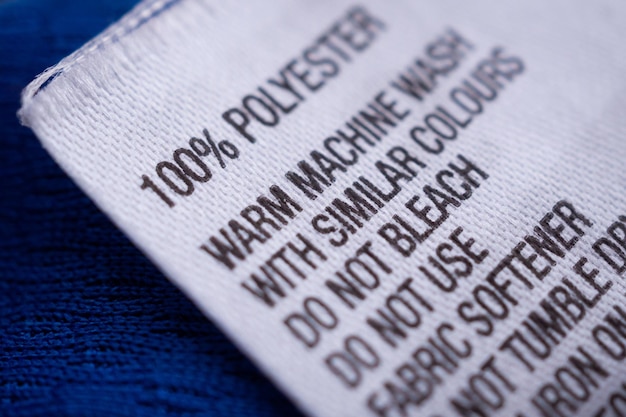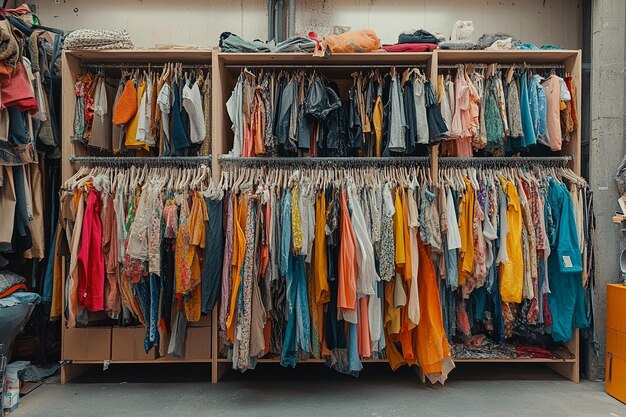Sustainable Fashion Trends: Eco-Friendly Choices in 2025

Sustainable fashion is gaining significant traction as consumers increasingly prioritize eco-friendly choices, leading to innovative approaches in clothing production, consumption, and disposal in 2025.
Sustainable fashion is trending: How consumers are making more eco-friendly choices in 2025. The fashion industry is undergoing a radical transformation, with environmental consciousness becoming a key driver for consumer behavior. Discover how these choices are shaping the future of the industry.
The Rise of Eco-Conscious Consumers
Consumers are becoming overwhelmingly aware of their impact on the planet, and this heightened awareness is directly influencing their purchasing decisions. The fashion industry, long criticized for its environmental footprint, is now facing increased pressure to adopt more sustainable practices. This shift towards eco-consciousness is reshaping the industry from the ground up.
Transparency and Traceability
Consumers are demanding greater transparency from brands regarding their supply chains. They want to know where their clothes are made, who made them, and what materials were used. Technologies like blockchain are being implemented to provide full traceability, allowing consumers to verify the authenticity and sustainability of their purchases.
The Power of Information
Easy access to information is empowering consumers. They are using online resources, apps, and social media to research brands and products, seeking out those with strong environmental and social credentials. This informed decision-making is driving the demand for sustainable fashion and pushing brands to be more accountable.
- 🌱 Increased awareness of environmental issues
- 🔍 Demand for transparency and traceability
- 📱 Leveraging technology for informed choices
- 🗣️ Social media’s role in promoting sustainable brands
As consumers become more informed and engaged, the pressure on the fashion industry to adopt sustainable practices will only intensify. This rising tide of eco-consciousness is not just a trend, but a fundamental shift in consumer values, poised to reshape the future of fashion.

Innovative Materials and Technologies
The quest for sustainable fashion is driving innovation in materials and technologies. Designers and manufacturers are exploring new ways to create clothing that is both stylish and eco-friendly. These advancements are paving the way for a more circular and environmentally responsible fashion industry.
Recycled and Upcycled Fabrics
Recycled materials are becoming increasingly popular in fashion. Fabrics made from recycled plastic bottles, fishing nets, and textile waste are being used to create a wide range of garments. Upcycling, the process of transforming waste materials into higher-value products, is also gaining traction, giving new life to discarded clothing and reducing landfill waste.
Bio-Based and Plant-Derived Materials
Innovations in bio-based materials are providing alternatives to traditional textiles. Fabrics made from materials like pineapple leaves (Piñatex), mushroom leather (Mylo), and algae fibers are emerging as sustainable options. These materials are renewable, biodegradable, and often require fewer resources to produce than conventional textiles.
- ♻️ Widespread use of recycled polyester and nylon
- 🍄 Development of bio-based leather alternatives
- 🌿 Innovations in plant-derived fabrics
- 🔬 Advanced dyeing and finishing techniques
These advancements in materials and technologies are revolutionizing the fashion industry, offering sustainable alternatives that reduce environmental impact. As these innovations continue to evolve, they will play an increasingly important role in creating a more eco-friendly and circular fashion system. Ultimately, the fashion industry is proving its comittment the the trending sustainable fashion.
The Circular Economy in Fashion
The circular economy is transforming the fashion industry by shifting away from the linear “take-make-dispose” model to a more regenerative and sustainable approach. This involves designing for durability, promoting reuse and recycling, and minimizing waste at every stage of the product lifecycle. The following paragraphs explore more on sustainable fashion becoming a reality.
Design for Durability and Longevity
Designing clothing to last longer is a cornerstone of the circular economy. Brands are focusing on creating timeless designs, using high-quality materials, and offering repair services to extend the lifespan of garments. This approach reduces the need for frequent replacements and minimizes textile waste.
Rental, Resale, and Subscription Models
New business models are emerging that promote the sharing and reuse of clothing. Rental services allow consumers to access designer items for special occasions without purchasing them outright. Resale platforms provide a marketplace for buying and selling pre-owned clothing, while subscription services offer a curated selection of garments on a regular basis.
- 🔄 Focus on product longevity and repairability
- 👗 Growth of rental and resale markets
- 📦 Subscription services promoting clothing rotation
- 🗑️ Extended Producer Responsibility (EPR) schemes
The circular economy is not just a concept, but a practical approach to transforming the fashion industry. By prioritizing durability, reuse, and recycling, the industry can minimize its environmental impact and create a more sustainable future for fashion. These concepts should be understood thoroughly to grasp the future of sustainable fashion.

Policy and Regulation Driving Change
Government policies and regulations are playing a crucial role in driving sustainable practices within the fashion industry. These measures are designed to hold brands accountable for their environmental impact and incentivize the adoption of more responsible production methods. This is all coming as sustainable fashion is trending up.
Extended Producer Responsibility (EPR)
EPR schemes are placing the responsibility for managing the end-of-life of products on the producers. This encourages brands to design products that are easier to recycle and to invest in infrastructure for collecting and processing textile waste. EPR is shifting the financial burden of waste management from municipalities to the companies that create the waste.
Eco-Labeling and Certification
Eco-labels and certifications provide consumers with reliable information about the environmental and social performance of products. Standards like GOTS (Global Organic Textile Standard) and Fair Trade help consumers identify clothing that meets specific criteria for sustainability. These certifications promote transparency and allow consumers to make informed purchasing decisions.
- 🏛️ Stricter environmental regulations for textile production
- 🏷️ Mandatory eco-labeling and certification schemes
- 💰 Financial incentives for sustainable practices
- 🤝 Collaboration between governments and industry stakeholders
Government policies and regulations are essential for creating a level playing field and driving systemic change within the fashion industry. By implementing EPR schemes, promoting eco-labeling, and providing financial incentives, governments can accelerate the transition to a more sustainable and responsible fashion system. It is clear governments have an increasingly important role to play as sustainable fashion goes up.
Consumer Behavior and the Secondhand Market
The way consumers shop for clothes is rapidly evolving, with a growing preference for secondhand and vintage items. This shift in consumer behavior is being driven by a desire to reduce waste, save money, and express individual style. The secondhand market is becoming a significant force in the fashion industry, challenging traditional models of consumption.
Thrifting and Vintage Shopping
Thrifting and vintage shopping are gaining popularity as consumers seek out unique and affordable clothing options. These practices not only reduce waste but also allow consumers to discover one-of-a-kind pieces that reflect their personal style. The thrill of the hunt and the satisfaction of finding a hidden gem are driving the appeal of secondhand shopping.
Online Resale Platforms
Online platforms are making it easier than ever to buy and sell pre-owned clothing. These platforms provide a convenient and accessible marketplace for consumers to connect with each other and participate in the circular economy. The rise of online resale is democratizing fashion and empowering consumers to extend the lifespan of their clothes.
- 🛍️ Increased interest in thrifting and vintage fashion
- 💻 Growth of online resale platforms like ThredUp and Poshmark
- 🌍 Community-driven initiatives for clothing swaps and exchanges
- 💡 Educational campaigns promoting conscious consumption
Changes in consumer behavior towards secondhand and vintage are creating opportunities for sustainable fashion. It is up to consumers to reduce waste, save money, and express individual style. The secondhand market can challenge traditional models of consumption.
The Role of Technology in Sustainable Fashion
Technology is playing a transformative role in advancing sustainable fashion, offering innovative solutions to address environmental challenges and improve transparency across the supply chain. From advanced materials to smart manufacturing processes, technology is paving the way for a more responsible and efficient fashion industry. All of these technological opportunities give consumers more eco-friendly options for sustainable fashion in 2025.
3D Printing and On-Demand Manufacturing
3D printing technology is allowing designers to create custom-fit clothing with minimal waste. On-demand manufacturing reduces the need for mass production and allows brands to produce garments only when they are needed, minimizing excess inventory and reducing environmental impact.
AI and Data Analytics for Supply Chain Optimization
Artificial intelligence (AI) and data analytics are being used to optimize supply chains, reduce waste, and improve efficiency. AI algorithms can predict demand, optimize inventory levels, and identify opportunities to reduce energy consumption and emissions. These technologies are helping brands make more informed decisions and operate more sustainably.
- 🚀 Use of blockchain for supply chain traceability
- 🤖 AI-powered design and manufacturing processes
- 📱 Smart technologies for fabric recycling and sorting
- 🌐 Virtual reality (VR) and augmented reality (AR) for virtual try-ons
Technology is driving innovation in sustainable fashion, offering solutions to address its environmental impact. With the aid of advanced materials to smart manufacturing processes, technology can pave the way for a more responsible and efficient fashion industry.
| Key Point | Brief Description |
|---|---|
| 🌱 Eco-Conscious Consumers | Consumers are prioritizing transparency and sustainability in their fashion choices. |
| ♻️ Circular Economy | Focus on durability, reuse, rental and recycled practices, to minimize waste. |
| 🏛️ Government Policies | Regulations and incentives drive sustainable practices in the fashion industry. |
| 💻 Technology | Innovations like 3D printing and AI optimize supply chains and reduce waste. |
FAQ About Sustainable Fashion
▼
Sustainable fashion refers products that consider ecological and social impacts throughout its lifecycle, aiming to minimize environmental harm and ensure fair labor practices.
▼
It addresses the negative impacts of the fashion industry, such as pollution, resource depletion, and unethical labor conditions, promoting a more responsible and ethical approach.
▼
Consumers can buy from brands with strong ethical values, purchase secondhand clothing, opt for durable items, and properly care for their garments to extend their lifespan.
▼
Common materials include organic cotton, recycled polyester, hemp, bamboo, and innovative materials made from pineapple leaves, mushroom leather, and algae fibers.
▼
Extended Producer Responsibility (EPR) schemes and eco-labeling help hold brands accountable, incentivizing them to adopt more responsible production methods and providing consumers with reliable information.
Conclusion
As we move further into 2025, the trend toward sustainable fashion is becoming more than just a passing fad; it’s a fundamental shift in how consumers perceive and interact with the fashion industry. By embracing eco-friendly choices, supporting innovative materials, and advocating for policy changes, consumers are driving a transformation that promises a more responsible and sustainable future for fashion.